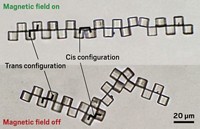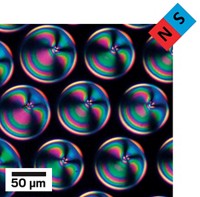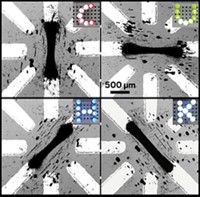Advertisement
Grab your lab coat. Let's get started
Welcome!
Welcome!
Create an account below to get 6 C&EN articles per month, receive newsletters and more - all free.
It seems this is your first time logging in online. Please enter the following information to continue.
As an ACS member you automatically get access to this site. All we need is few more details to create your reading experience.
Not you? Sign in with a different account.
Not you? Sign in with a different account.
ERROR 1
ERROR 1
ERROR 2
ERROR 2
ERROR 2
ERROR 2
ERROR 2
Password and Confirm password must match.
If you have an ACS member number, please enter it here so we can link this account to your membership. (optional)
ERROR 2
ACS values your privacy. By submitting your information, you are gaining access to C&EN and subscribing to our weekly newsletter. We use the information you provide to make your reading experience better, and we will never sell your data to third party members.
Materials
Magnetic fields cause microcubes to respond like mini robots
Strategy for remotely controlling the motions of microscopic particles could hasten development of artificial muscle and biomimetic devices
by Mitch Jacoby
August 7, 2017
| A version of this story appeared in
Volume 95, Issue 32

Hours of practice enable marching band members to smoothly step through one orderly formation after another. Some colloidal particles can also do that fancy footwork, but they don’t need to practice. A team of researchers including Koohee Han and Orlin D. Velev of North Carolina State University made polymer cubes with 10-µm-long edges and selectively coated one face of each cube with a 100-nm-thick film of cobalt, which can be magnetized. Then they formed aqueous suspensions of the microcubes and showed that by controlling the way magnetic fields were applied to the suspensions, including switching the fields on and off and superimposing fields from multiple electromagnets, the cubes could be made to spontaneously and reversibly assemble in a variety of shapes and patterns (Sci. Adv. 2017, DOI: 10.1126/sciadv.1701108). In some cases, the cubes reversibly switched between a linear chain and ringlike configuration. In others, the cubes underwent complex folding, unfolding, and rotational motions. In yet another display of control, the team used a pattern of cubes to capture and transport a live cell and then release it. The researchers propose that this strategy may one day be used to develop microbots, artificial muscles, and other biomimetic devices.





Join the conversation
Contact the reporter
Submit a Letter to the Editor for publication
Engage with us on Twitter